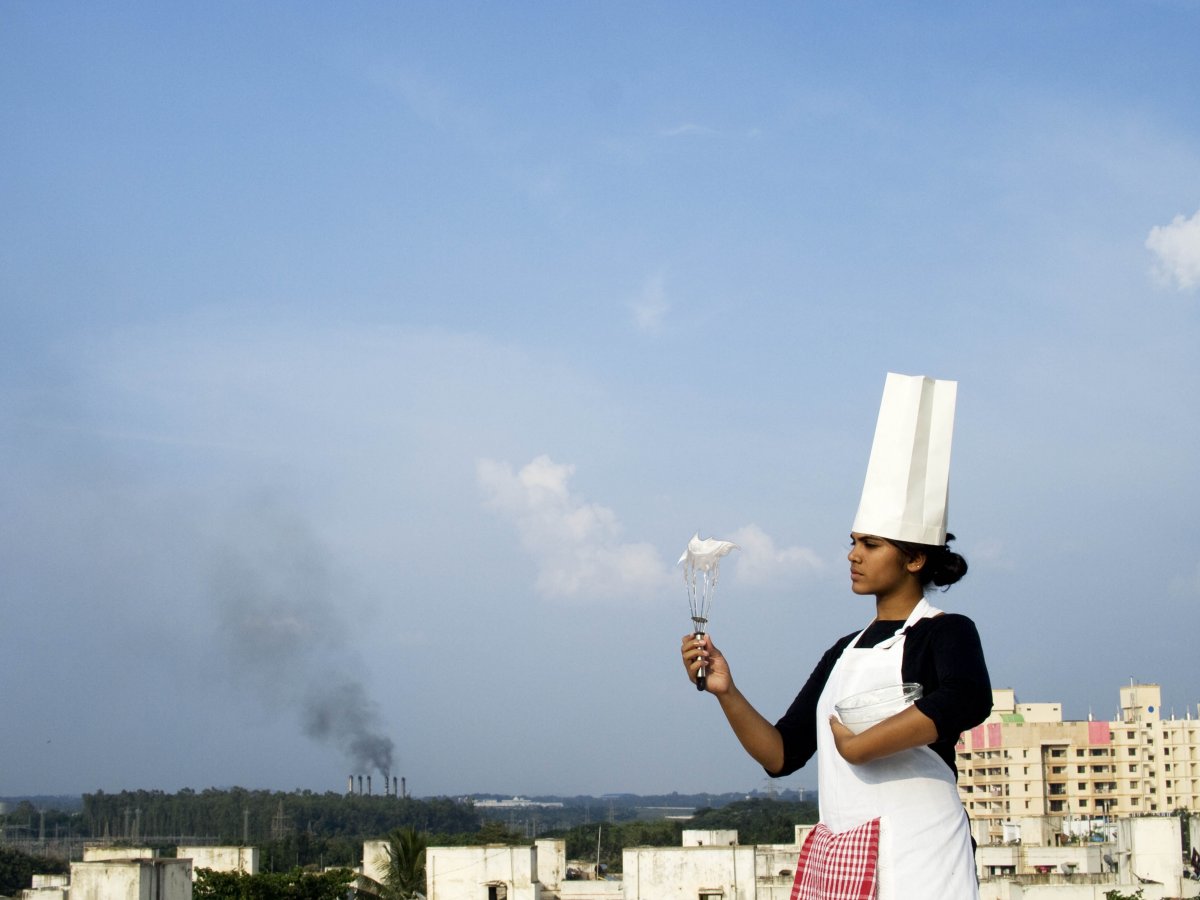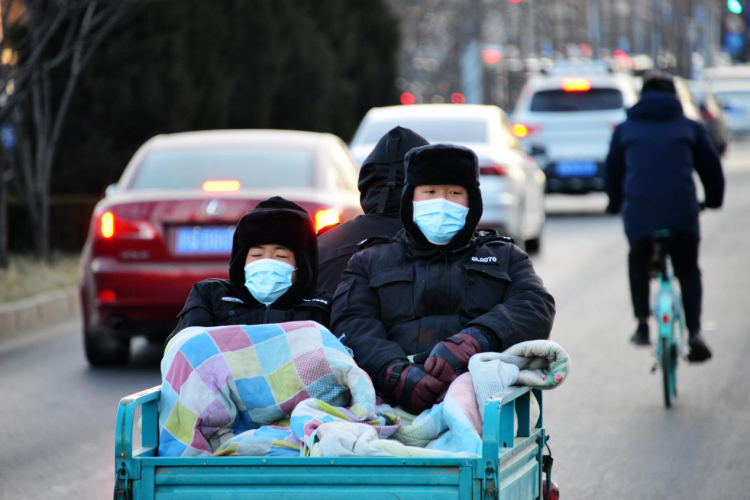Smog Tasting Takes Open-Air Cooking to a Whole New Level
In December 2017 a group of leading behavioral scientists, environmental conservationists, and media scholars gathered in Washington, DC for a Fuller Symposium sponsored by the World Wildlife Fund and National Geographic entitled The Nature of Change: The Science of Influencing Behavior. As its name suggests, the event was aimed at harnessing what we know about human behavior to usher in conservation efforts and ultimately stave off the impending doom of climate change. Among the standard slate of lectures and presentations, one group sought to frame the discussion in a much more immediate and visceral way.
The Center for Genomic Gastronomy is a diverse group of artists, designers, scientists, and chefs that look at how human food systems impact both populations and the environment, through the lens of biotechnology and biodiversity. Given the interdisciplinary makeup of their organization, the team is adept at devising unique and innovative ways to start conversations around the topics they seek to address. As such, for the Fuller Symposium, they rolled out their extraordinary, if not slightly unpalatable initiative, Smog Tasting: Take Out.

Initially dreamt up and executed in India in 2011, the Smog Tasting project “maps air quality by harvesting air from highly polluted areas.” Seems innocent enough until you find out that the air harvesting is achieved by whipping egg foams in city centers and subsequently turning those foams into meringues. Yum! Given that egg foams are basically just air, whipping them outdoors causes particulate matter to be trapped in the batter. As a result, “The batter can be tested for heavy metals and volatile organic compounds (VOCs),” which can then be “compared in a microscope or baked and served as Trojan horse sweets.” Double yum!
Given the success of their initial tests in 2011, the Center for Genomic Gastronomy decided to take their delectable experiment on the road, so to speak, and whipped up some meringues in London, Perth, Barcelona, Washington DC, Porto, Mumbai, and of course, the hub of grade-a smog production, Beijing, which they served up at the Fuller Symposium.
So what exactly does Beijing smog taste like when disguised as a fluffy little meringue? According to writer and journalist Nicola Twilley, “It has that kind of fart smell going on.”
To find out more about the Beijing chapter of Smog Tasting: Take Out, we spoke via email with Zack Denfeld, Outreach Coordinator for the Center for Genomic Gastronomy and CoClimate.

Did you collaborate with anyone in Beijing during your time here?
For this version of Smog Tasting, we only collaborated via the internet and postal service, but we have previously had the chance to visit Dalian, and recently Shunde, while doing field research for food and art projects. I have been an attendee at the World Economic Forum in Dalian a few years ago, and working with the HE Art Museum over the last year on a new commissioned piece.

What gives Beijing’s air that sulfuric quality?
Vehicle traffic and coal, but also the use of formaldehyde as well, apparently.
From a New York Times article, “The main particulate matter in pollution in China has long been thought to be sulfate, a product of sulfur dioxide released by burning coal. But another sulfur molecule, hydroxymethane sulfonate is also a significant contributor, according to [a] study conducted with scientists from Tsinghua University in Beijing and the Harbin Institute of Technology in Harbin, the capital of China’s northernmost province, Heilongjiang. The molecule is formed by a chemical reaction between formaldehyde and sulfur dioxide, and explains why ‘extreme air pollution events’ have persisted despite the efforts to cut sulfur emissions, the researchers found.”

Would you expect the same flavor profile if you came back?
Hm… I have high hopes, with China’s focus on going green, but I was just in Shunde in January and the air quality was rough! I know that China is attempting to really reduce urban air quality in a variety of ways: fuel switch of vehicles to electric, tying local and regional party advancement to new measurements such as reduced air pollution and not just increased GDP, and moving coal-fired power plants further away from city centers.
Unfortunately, it sounds like there are a lot of perverse incentives or competing incentives anyways between economic growth, jobs, and going green. Same as everywhere I think.
There is also the danger that as China develops national renewables it sends out it's trained experts in Coal to Africa, etc. simply displacing the smog. Norway (where I currently live) has the same problem, not only in leaving carbon in the ground, but also figuring out what to do with all of the petroleum engineers they have trained for the last two generations.

Anything else of particular interest, or that I might have missed?
One piece of hopeful news is that we might be at peak air pollution locally and globally, and going downwards over the next decades, even as human population increases. As we move away from coal and the internal combustion engine, and generally the use of fossil fuels, local air quality will improve and smog tasting will become less intense.
The question of a cleaner air future was addressed during the swift international reaction to the COVID-19 pandemic in the spring of 2020. Many causes of air pollution dropped dramatically due to the implementation of social distancing and lockdown measures. This unique moment in history may give us a preview of what the atmospheric taste of a place could look and smell like if we travel down the other side of peak air pollution.
As the air quality and smell of cities changed overnight, The Center for Genomic Gastronomy / CoClimate created a Guided Smog Smelling series to activate our bodies, lungs and sense of smell (over the internet, into the homes of our participants) and to experience with intent, the unique atmospheric event we were all living through.
Even before the COVID-19 pandemic, regions like the US, Western Europe, and Mexico have seen a decrease in PM 2.5 pollution. At the same time, others like India and Northern Africa have increased significantly. Is this because some countries are “cleaning up,” installing alternative energy systems, reducing waste, and minimizing pollution with better technologies? Or is it because some of us are outsourcing our pollution to neighbors nearby or across the world? Who controls the means of pollution production anyway?
As climate change forces us to look skyward towards something that is hard to pinpoint, Smog Tasting aims to contribute to a conversation about how to inhabit our planet, and its atmosphere, with more care. It is one method for independent researchers around the world to connect, taste, and smell with intentionality—imagining and working towards an aeroir that is healthier and more just for future generations.
READ: Will Insatiable Diners be Able to Prevent Invasive Species From Spreading?
Images: courtesy of The Center for Genomic Gastronomy







